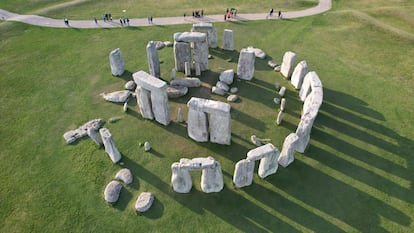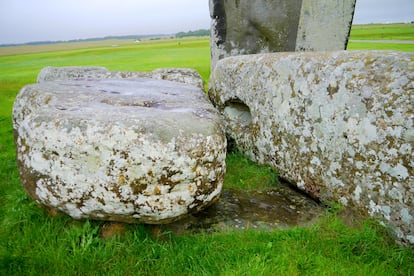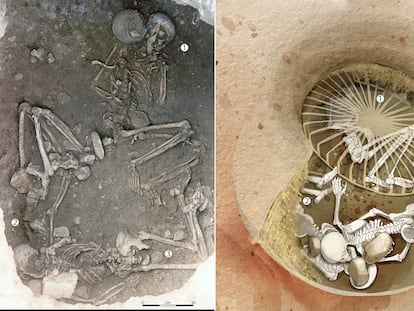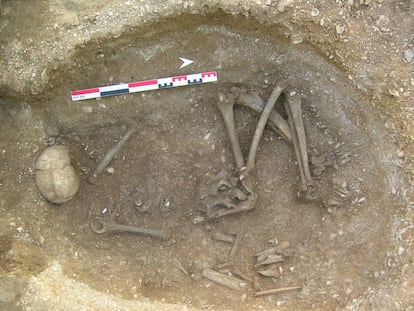New mystery at Stonehenge: The six-ton altar stone traveled over 435 miles from northern Scotland
Geologists and archaeologists have identified the origin of the enormous rock in the Orkney Basin and believe it was carried to the south of England along the coast

It was the main element of the Stonehenge complex that remained to be identified. Construction at the site began just under 5,000 years ago and the outermost megaliths, the so-called sarsen stones, came from a nearby quarry, some 25 kilometers to the north. The inner circle, the one with the blue stones, came from much further away, from the Preseli Mountains in Wales, a distance of some 250 kilometers (155 miles) from Stonehenge. Considering that what the Romans would later call Britannia was in the middle of the Neolithic period, even with many technological limitations the distance was enormous. At the center, at some point during its erection, its creators placed an enormous blue rock as an altar. For years there has been debate over its origin. Now, by combining sophisticated scientific and mining techniques, researchers have been able to date it and, more importantly, to pinpoint its origin: it came from the Orkney Basin, at the northern tip of present-day Scotland. How, and why, did they go there to look for an enormous stone? How, and why, was it transported to the south of what is now England? The lack of definitive answers adds to the mystery surrounding Stonehenge.
Richard Bevins, an honorary professor at Aberystwyth University (UK), and his former student, geologist Nick Pearce, had been studying the altar at Stonehenge for years. As researchers at a Welsh institution, they were trying to confirm that the central element of the English monument was also Welsh. The last attempt was made in 2018. “The altar stone is in the center of the monument and it is a bluestone, although very different from the others. It is about twice the size of the smallest igneous bluestones, weighs six tons, and is five metres long; the others are about three tons at most,” Pearce said during an online press conference. “It is a type of rock, a greyish-green sandstone, that everyone in the UK seemed to be at a loss for,” he added. In the end they had to give up and admit in a scientific paper that the altar was not Welsh. They then decided to look for the quarry in England and southern Scotland. They were in the middle of this when they received an email from Anthony Clarke, a Welsh PhD student at Curtin University (Australia).
It is a type of rock, a greyish-green sandstone, that everyone in the UK seemed to be at a loss for”Nick Pearce, geologist at the University of Aberystwyth (UK)
“My PhD was about dating Welsh rocks (unrelated to Stonehenge) using the isotopes they contain. Nick asked me, ‘Would you like to try and analyse the altar stone?’ Before I knew it, I was being sent samples for analysis in Australia,” Clarke says. “Why Australia? Why send material halfway around the planet to be analysed? It’s because of the variety of equipment we have at Curtin University, partly because of the mining industry in Western Australia. If you want to understand where your next iron ore deposit might be, you’ll use the same tools to work out where the altar stone came from.”
The altar stone is a sandstone, which means that it is made up of many tiny microscopic grains of minerals. José Antonio Lozano, a geologist from the Spanish Oceanographic Institute (IEO-CSIC) who did not participate in the study, notes that for “past societies it was a very good rock, because it could be carved; in fact, many of the cathedrals, Renaissance, and medieval buildings in the south of the Iberian Peninsula are made of sandstone.” Those microscopic grains — their presence, distribution, and age — give a particular stone a kind of imprint that tells us about its origin. “It is vital to make maps of your territory. Geologists have gone into the field with a hammer, a magnifying glass, a compass, a map and good boots and you determine on the map what materials there are. Then you make very detailed studies of the age of each of these materials, how they were formed, their genesis. These maps are key to the strategic resources of each country, to know where you can find gas, rocks for a quarry, aggregates for roads...” explains Lozano.
What the British scientists did was obtain the petrographic fingerprint of the altar and compare it with that of different regions of Great Britain. To complete the picture, they used the presence in the rock of small quantities of three minerals — zircon, apatite and rutile — which, as Clarke, lead author of the research, notes, “fortunately for us as geologists, contain uranium:” that is, they emit detectable radiation. “Over time, uranium decays into lead and acts as a miniature atomic clock,” he adds. “If we analysed enough grains within the altar stone, we could build a fingerprint of its age, comparing it with rock outcrops throughout Great Britain and Ireland, and even northern Europe.” The place where rocks like that of the altar exist is the Orkney Basin, in the far north of Scotland.

Lozano highlights the main strength, but also the primary limitation, of these results: “That fingerprint is a statistic. That is, what they have seen is that there are zircons that give a peak at one billion years, another peak at 1.5 billion years, another at 1.6 billion years... and it leads them to say that these age peaks make the altar sandstone more similar to Orkney sandstone than to any other.” To settle the question, they would have to locate the exact quarry the stone came from — something they are going to try to do — although it will not be easy after almost 5,000 years.
The rest of the work, published in the scientific journal Nature, is necessarily more speculative. The history of the stones is easier to reconstruct than that of their transport, or the motivations that led the people of the British Neolithic to move them from one end of the island to the other, more than 700 kilometres (435 miles) if they had traveled in a straight line. As for the former, carrying a stone of this weight and size by means of some cargo transport seems hardly credible. At that time, the inhabitants of the island did not yet have riding horses. The sarsen and blue stones of the rest of the complex could have been moved using logs, in the case of the former, and perhaps by sea for those of Welsh origin. The possibility that the altar stone was brought down from Scotland taking advantage of the large expanses of ice that remained from the last glaciation has been ruled out. It could have worked in the north, but by then, the glaciers in England had almost disappeared. By a process of elimination, the only route left is by sea.
Elías López Romero, a researcher at the Mérida Institute of Archaeology in Spain, recalls that although the British Neolithic period is later than the continental Neolithic, and even later still than the Iberian Neolithic, “long distances were already being traveled.” No remains of boats are preserved, although river canoes are, but references to them have been found in the megaliths themselves..
In the Neolithic, the alignments of Carnac [France], the dolmen of Antequera, and Stonehenge functioned as a social medicine. When the Bronze Age arrived, they disappeared and were replaced by violence”Leonardo García Sanjuan, archaeologist at the University of Seville
The other big question is why: what would lead a stone mass to be uprooted from the north and transported to the south? “We are back in the realm of interpretations,” says López Romero. There are several levels of symbolism involved. “There is the symbolism of color, which many specialist archaeologists have mentioned; the colors green and blue are also important in this case,” says the Spanish scientist, who is not connected with the research. There is also the origin. The region where the stone was extracted was home to the settlement of Orkney, in the far north of Scotland. That entire region is full of megalithic monuments, but Orkney is considered the most important Neolithic settlement in the British Isles at that time, being the only one with stone foundations.
And finally, there is the destination: Stonehenge. Leonardo García Sanjuan, an archaeologist at the University of Seville, agrees that the Orkney area was the most advanced of that culture. “But, like the rest of the island, they were isolated communities that formed temporary aggregations once or twice a year in special places to satisfy many needs: commercial, political, spiritual, biological...” he says. “In Stonehenge, as in Antequera [Málaga], thousands of people gathered for days, especially around the solstices, and they brought with them large stones that they considered special. The mobility of these rocks allows us to trace the movements of human communities,” he adds. “In the Neolithic, the alignments of Carnac [France], the dolmen of Antequera, and Stonehenge functioned as a social medicine. When the Bronze Age arrived, they disappeared and were replaced by violence.”
Sign up for our weekly newsletter to get more English-language news coverage from EL PAÍS USA Edition
Tu suscripción se está usando en otro dispositivo
¿Quieres añadir otro usuario a tu suscripción?
Si continúas leyendo en este dispositivo, no se podrá leer en el otro.
FlechaTu suscripción se está usando en otro dispositivo y solo puedes acceder a EL PAÍS desde un dispositivo a la vez.
Si quieres compartir tu cuenta, cambia tu suscripción a la modalidad Premium, así podrás añadir otro usuario. Cada uno accederá con su propia cuenta de email, lo que os permitirá personalizar vuestra experiencia en EL PAÍS.
¿Tienes una suscripción de empresa? Accede aquí para contratar más cuentas.
En el caso de no saber quién está usando tu cuenta, te recomendamos cambiar tu contraseña aquí.
Si decides continuar compartiendo tu cuenta, este mensaje se mostrará en tu dispositivo y en el de la otra persona que está usando tu cuenta de forma indefinida, afectando a tu experiencia de lectura. Puedes consultar aquí los términos y condiciones de la suscripción digital.
More information
Archived In
Últimas noticias
Most viewed
- Sinaloa Cartel war is taking its toll on Los Chapitos
- Oona Chaplin: ‘I told James Cameron that I was living in a treehouse and starting a permaculture project with a friend’
- Reinhard Genzel, Nobel laureate in physics: ‘One-minute videos will never give you the truth’
- Why the price of coffee has skyrocketed: from Brazilian plantations to specialty coffee houses
- Silver prices are going crazy: This is what’s fueling the rally











































